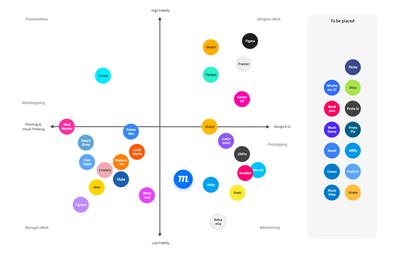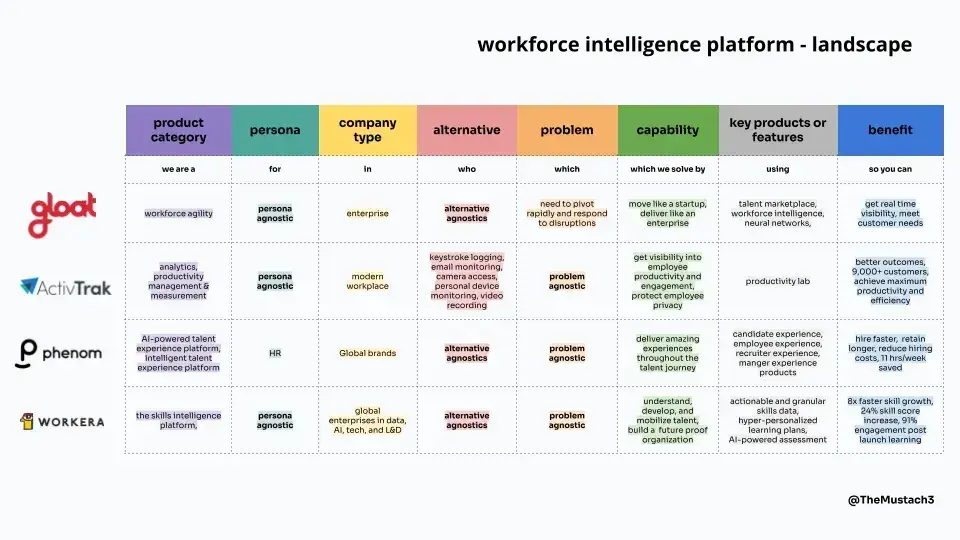Understanding your competitors is crucial for business success. Competitor analysis helps you identify your strengths and weaknesses.
In today’s fast-paced market, staying ahead of the competition is vital. A thorough competitor analysis can give you valuable insights into your industry’s landscape. It helps you understand what your competitors are doing right and where they are falling short.
This information allows you to make informed decisions, refine your strategies, and stay competitive. Whether you’re a small startup or a large corporation, competitor analysis is a powerful tool. It enables you to anticipate market trends, spot opportunities, and avoid potential pitfalls. So, let’s dive into the essentials of competitor analysis and discover how it can benefit your business.
Table of Contents
ToggleIntroduction To Competitor Analysis
Competitor analysis is a critical component of any successful business strategy. It involves identifying and evaluating your competitors to understand their strengths, weaknesses, and market position. By doing so, you can gain valuable insights that help your business stay competitive and grow.
Purpose And Importance
The primary purpose of competitor analysis is to understand the competitive landscape. This understanding allows businesses to make informed decisions and develop strategies that give them a competitive edge. It helps identify opportunities and threats in the market.
Competitor analysis is important because it provides a clear picture of what you are up against. Knowing your competitors’ strategies, strengths, and weaknesses enables you to position your products or services more effectively.
Key Benefits
Conducting competitor analysis offers several key benefits:
- Market Insights: Gain a deeper understanding of the market and customer preferences.
- Identify Opportunities: Discover gaps in the market that your business can exploit.
- Benchmarking: Compare your performance with competitors to identify areas for improvement.
- Risk Management: Anticipate potential challenges and prepare strategies to overcome them.
- Innovation: Inspire new ideas by analyzing competitors’ successful strategies.
Below is a table summarizing these benefits:
| Benefit | Description |
|---|---|
| Market Insights | Understand market trends and customer preferences. |
| Identify Opportunities | Find gaps in the market to capitalize on. |
| Benchmarking | Compare your business against competitors. |
| Risk Management | Predict and prepare for potential market challenges. |
| Innovation | Generate new ideas from competitors’ successes. |
Effective competitor analysis helps your business stay ahead of the competition. It ensures you are always aware of industry trends and market dynamics.

Credit: moqups.com
Identifying Competitors
Understanding your competition is crucial for business success. Identifying competitors helps you learn from their strengths and weaknesses. This section will help you identify your competitors effectively.
Direct Vs Indirect Competitors
Competitors can be divided into two types: direct and indirect. It’s important to understand both.
Direct competitors offer the same products or services as you. For instance, if you sell coffee, other coffee shops are your direct competitors. They target the same audience and fulfill the same needs.
Indirect competitors offer different products or services that can satisfy the same customer need. For example, tea shops or smoothie bars are indirect competitors to coffee shops. They provide alternatives to customers looking for beverages.
Tools For Identification
Several tools can help you identify both direct and indirect competitors. These tools provide insights into your market and competition.
- Google Search: A simple search can show who ranks for your keywords. Look at the top results to identify potential competitors.
- Social Media: Platforms like Facebook, Twitter, and Instagram can reveal competitors. Check who your audience follows and engages with.
- SEMrush: This tool helps you analyze competitors’ keywords and traffic. It provides a detailed overview of their online presence.
- SimilarWeb: Use this tool to get insights into competitors’ website traffic and engagement. It shows where their traffic comes from and how they perform online.
- Ahrefs: This tool offers comprehensive competitor analysis. It helps identify competitors’ backlinks, organic search performance, and more.
Using these tools, you can gather valuable data about your competitors. This information helps you strategize and improve your business approach.
Gathering Competitor Data
Analyzing competitors is crucial for any business strategy. Gathering competitor data can provide valuable insights into their strengths and weaknesses. This information helps businesses stay ahead in the market. Here, we will explore how to collect this data using primary and secondary sources.
Primary Sources
Primary sources are direct ways to collect data from competitors. These methods offer firsthand information and are often the most reliable.
- Website Analysis: Examine competitors’ websites. Look at their design, content, and user experience. Note their product offerings and pricing.
- Customer Reviews: Read reviews on platforms like Google and Yelp. Understand customer sentiments and common complaints.
- Social Media: Follow competitors on social media. Observe their engagement and content strategy.
- Surveys: Conduct surveys with your target audience. Ask about their experiences with competitors.
Secondary Sources
Secondary sources provide indirect data. These sources are often published by third parties and can complement primary data.
- Industry Reports: Read reports from market research firms. These reports often include competitor analysis.
- News Articles: Look for news about competitors. Articles can reveal new strategies and market movements.
- Financial Statements: Public companies release financial statements. These documents offer insights into their financial health.
- Academic Papers: Research papers can provide in-depth analysis of industry trends and competitors.
Combining data from primary and secondary sources offers a comprehensive view. This approach ensures you have both detailed and broad insights.

Credit: blog.hubspot.com
Analyzing Competitor Strategies
Understanding your competitors is key to staying ahead in your market. Analyzing their strategies helps you identify strengths and weaknesses. This way, you can improve your own approach. Let’s dive into some crucial aspects of competitor analysis.
Marketing Tactics
Competitors often employ diverse marketing tactics to capture their audience. By studying these tactics, you can learn what works and what doesn’t. Here are some key areas to focus on:
- Social Media Presence: Look at their activity on platforms like Facebook, Instagram, and Twitter.
- Content Strategy: Analyze the types of content they publish. Check for blog posts, videos, and infographics.
- Email Marketing: Subscribe to their newsletters to see their email marketing strategies.
- SEO Practices: Use tools to check their keyword strategies and backlink profiles.
Product Offerings
Understanding what products your competitors offer is crucial. It helps you identify gaps in your own product line. Here are some factors to consider:
- Product Range: List the types of products they sell. Compare this with your offerings.
- Pricing Strategy: Note their pricing. Are they higher, lower, or similar to yours?
- Quality and Features: Evaluate the quality and features of their products. How do they stack up against yours?
- Customer Reviews: Read reviews to understand customer satisfaction. Look for common praise or complaints.
Use this information to refine your own products and strategies. This will give you a competitive edge.
Evaluating Market Position
Evaluating Market Position is crucial for understanding how your business stacks up against competitors. It helps identify strengths, weaknesses, opportunities, and threats in the market. This process ensures you can make informed decisions and craft effective strategies.
Market Share Analysis
Market Share Analysis gives you a clear picture of your business’s standing. It shows the percentage of the market your business controls compared to competitors.
To perform a Market Share Analysis, gather data on:
- Total market size
- Competitors’ sales
- Your sales
Compare these figures to determine your share. For example:
| Company | Sales (in million $) | Market Share (%) |
|---|---|---|
| Company A | 500 | 25% |
| Company B | 300 | 15% |
| Your Business | 700 | 35% |
From this table, it is clear that your business has a 35% market share, the highest among competitors.
Swot Analysis
A SWOT Analysis helps to evaluate the internal and external factors affecting your market position. It stands for:
- Strengths: Internal attributes that give your business an edge.
- Weaknesses: Internal attributes that could hinder success.
- Opportunities: External factors you can leverage for growth.
- Threats: External factors that could pose challenges.
To conduct a SWOT Analysis, consider the following:
- Identify your strengths, such as brand reputation or unique products.
- List weaknesses, like limited resources or lack of expertise.
- Spot opportunities, such as market trends or new technologies.
- Recognize threats, including new competitors or changing regulations.
Here’s an example table of a SWOT Analysis:
| SWOT | Details |
|---|---|
| Strengths | Strong brand, loyal customer base |
| Weaknesses | High production costs, limited online presence |
| Opportunities | Growing market, technological advancements |
| Threats | New competitors, economic downturn |
This analysis helps in crafting strategies to enhance strengths, mitigate weaknesses, seize opportunities, and counter threats.
Understanding Customer Perceptions
Understanding customer perceptions is vital in competitor analysis. It allows businesses to gauge how customers view their rivals. This insight can help refine strategies and improve customer satisfaction.
Customer Reviews And Feedback
Customer reviews and feedback provide a wealth of information. They reveal what customers like or dislike about products or services. Businesses can use this data to identify strengths and weaknesses of competitors.
Positive reviews can highlight areas where competitors excel. Negative reviews can pinpoint common problems. Analyzing this information can help improve your own offerings. Here are some key points to look for in reviews:
- Common complaints
- Praise for specific features
- Suggestions for improvements
- Customer service feedback
Social Media Insights
Social media is a goldmine of customer perceptions. People freely share their experiences and opinions online. Analyzing social media can provide real-time insights into customer sentiment.
Look for patterns in social media mentions. Pay attention to the tone of comments. Are customers happy or frustrated? Here are some tools and methods to gather social media insights:
- Social media monitoring tools (e.g., Hootsuite, Brandwatch)
- Hashtag analysis
- Sentiment analysis tools
- Engagement metrics (likes, shares, comments)
Use this data to understand how competitors are perceived. This can help you adjust your strategy to better meet customer needs.
Benchmarking Performance
Benchmarking performance helps you understand how your business measures up against your competitors. It involves comparing various metrics to identify strengths and weaknesses. This process provides insights into areas where you can improve. By analyzing competitors, you can set realistic goals and strategies to enhance your own performance.
Key Performance Indicators
Key Performance Indicators (KPIs) are crucial metrics that show how well your business is performing. They help you track progress towards your goals. Common KPIs include:
- Revenue Growth: Measures the increase in sales over a period.
- Customer Acquisition Cost: The cost to acquire a new customer.
- Conversion Rate: The percentage of visitors who take a desired action.
- Customer Retention Rate: The percentage of customers who continue to buy from you.
- Net Promoter Score (NPS): Measures customer loyalty and satisfaction.
Tracking these KPIs helps you understand your business performance. It also helps you compare your performance with your competitors.
Comparative Analysis
A comparative analysis helps you see where you stand in your industry. It involves comparing your KPIs with those of your competitors. This helps you identify gaps and opportunities for improvement. Here are some steps to conduct a comparative analysis:
- Identify your main competitors.
- Gather data on their KPIs.
- Compare their KPIs with your own.
- Identify areas where you lag behind.
- Develop strategies to improve in those areas.
Using a table can make this process easier. Here’s an example:
| Metric | Your Business | Competitor A | Competitor B |
|---|---|---|---|
| Revenue Growth | 10% | 12% | 15% |
| Customer Acquisition Cost | $50 | $45 | $40 |
| Conversion Rate | 5% | 6% | 7% |
| Customer Retention Rate | 80% | 85% | 90% |
| Net Promoter Score (NPS) | 70 | 75 | 80 |
By examining this table, you can see where your business stands. This helps you make informed decisions to improve your performance.
Formulating Competitive Strategies
Formulating competitive strategies is essential for any business aiming to succeed. By understanding and analyzing your competitors, you can craft effective strategies to stand out. This process involves several tactics, including differentiation and innovation. Let’s delve deeper into these strategies.
Differentiation Tactics
To stand out in the market, you must differentiate your products or services. Here are some effective differentiation tactics:
- Quality: Offer superior quality products that last longer and perform better.
- Pricing: Use competitive pricing to attract cost-conscious customers.
- Branding: Develop a strong brand identity that resonates with your audience.
- Customer Service: Provide exceptional customer service to create loyal customers.
Using these tactics can help your business gain a competitive edge.
Innovation And Improvement
Innovation and continuous improvement are key to staying ahead. Here are some approaches to consider:
- Product Innovation: Regularly update and improve your products.
- Process Improvement: Streamline processes to increase efficiency.
- Market Research: Conduct ongoing market research to identify new trends.
- Technology Adoption: Embrace new technologies to enhance operations.
By focusing on innovation, your business can lead the market.
| Strategy | Description |
|---|---|
| Differentiation | Setting your product apart from competitors. |
| Innovation | Introducing new and improved products. |
Continuous Monitoring
Continuous monitoring is crucial in competitor analysis. It involves keeping an eye on your competitors’ activities, strategies, and changes. This process helps you stay updated and adapt quickly. Regular monitoring ensures you are not left behind in the competitive landscape.
Regular Updates
Keeping track of your competitors requires regular updates. This means checking their websites, social media, and news. You can use tools like Google Alerts to get notifications. Regular updates help you understand their new strategies. They also show you market trends and changes in customer preferences.
| Tool | Purpose |
|---|---|
| Google Alerts | Get notifications about competitors |
| Social Media Monitoring Tools | Track social media activities |
| SEO Tools | Analyze website changes |
Adaptation And Flexibility
Adaptation and flexibility are key in competitor analysis. Markets change quickly, and so do competitors’ strategies. Your business must be able to adapt. This means being ready to change your strategies. Flexibility helps you stay ahead in the market.
To stay flexible, consider the following steps:
- Analyze your competitors’ new products or services
- Adjust your marketing strategies based on their moves
- Stay updated with industry trends
Being flexible means you are always ready for change. This keeps your business competitive and resilient.
Conclusion And Action Plan
Conducting a thorough competitor analysis is essential for understanding market dynamics. It helps businesses identify opportunities and threats. This section will summarize the insights gained and outline the next steps to take.
Summary Of Insights
After analyzing competitors, several key insights emerged:
- Competitor A has a strong social media presence.
- Competitor B offers more competitive pricing.
- Competitor C excels in customer service.
These insights reveal areas where our business can improve. They also highlight our strengths. For example, our product quality remains unmatched. Yet, there’s room for improvement in our pricing strategy and social media engagement. One way we can address this is by conducting a thorough analysis of our pricing structure to ensure we remain competitive without sacrificing profitability. Additionally, we can increase our social media engagement by using social media sponsorships to reach a larger audience and drive more traffic to our platforms. These strategies will help us drive growth and continue to build on our strong foundation in the market.
Next Steps
Based on the insights, here are the next steps:
- Enhance Social Media Presence: Increase engagement on platforms where competitors excel. Post regularly and interact with followers.
- Review Pricing Strategy: Conduct a pricing analysis. Adjust prices to stay competitive while maintaining profit margins.
- Improve Customer Service: Implement training programs for support staff. Ensure quick and effective response times.
- Monitor Competitors: Regularly update the competitor analysis. Stay informed about their new strategies and offerings.
Implementing these steps will help our business stay competitive. Continual monitoring and adjustments are crucial. This ensures we respond effectively to market changes. Using analytics allows us to track key metrics and identify trends, giving us valuable insights into consumer preferences and market dynamics. By leveraging this data, we can make informed decisions and adapt our strategies accordingly. This will ultimately help us maintain our competitive edge and drive business growth in the long run.
By focusing on these areas, we can achieve better market positioning. Our goal is to provide the best value to our customers.

Credit: www.appinio.com
How Can Competitor Analysis Help Improve My SEO Strategy?
Competitor analysis is crucial to boost your seo strategy with keyword analysis software. By evaluating your competitors’ keywords and backlink profiles, you can identify new opportunities for optimization and content creation. This insight helps you stay ahead in the search rankings and improve your overall SEO performance. Understanding keyword difficulty is also essential in competitor analysis to choose the best keywords to target. By identifying which keywords have lower competition but still maintain good search volume, you can focus your efforts on optimizing for those terms. This can give you a competitive edge and help you rank higher in search engine results pages. Additionally, by understanding keyword difficulty, you can better prioritize your SEO efforts and allocate resources effectively. Furthermore, competitor analysis can also help you identify potential SEO keyword problems that may be impacting your performance. By comparing your own keyword strategy with that of your competitors, you can pinpoint areas for improvement and make adjustments to your SEO campaign. This allows you to continually refine your keyword targeting and stay ahead of the competition. Overall, using keyword analysis software in competitor analysis can provide valuable insights that help you optimize your SEO strategy and achieve better results.
How Can Competitor Analysis Help Improve E-Commerce Metrics and Sales in 2025?
In 2025, competitor analysis will continue to be vital for e-commerce success. By understanding what the competition is doing, you can gain valuable insights to boost your ecommerce sales metrics. Analyzing their strategies, pricing, and customer engagement can help you make informed decisions and stay ahead in the market.
Frequently Asked Questions
What Is Competitor Analysis?
Competitor analysis is the process of evaluating your competitors’ strategies. It helps understand their strengths and weaknesses. This information can improve your own business strategy.
Why Is Competitor Analysis Important?
Competitor analysis helps identify market trends and opportunities. It reveals strengths and weaknesses of competitors. This knowledge can give you a competitive edge.
How To Conduct A Competitor Analysis?
Start by identifying your key competitors. Analyze their strengths, weaknesses, pricing, and marketing strategies. Use tools like SWOT analysis and competitor benchmarking.
What Tools Are Used For Competitor Analysis?
Common tools include SEMrush, Ahrefs, and SpyFu. These tools help analyze competitors’ SEO strategies, keywords, and backlinks. They provide valuable insights for your own strategy.
How Can Real-Life SEO Success Stories Help in Competitor Analysis and Gaining an Edge in the Market?
Real-life SEO success stories, especially those brought about by mangools seo success, can provide valuable insights for competitor analysis. By analyzing the strategies and tactics used by successful businesses, companies can gain an edge in the market by implementing similar approaches to improve their own SEO performance.
Conclusion
Analyzing competitors offers valuable insights for business growth. Understand their strengths and weaknesses. Use this knowledge to improve your strategies. Stay ahead by constantly monitoring the market. Adapt quickly to changes and trends. Consistent analysis helps in making informed decisions.
Always strive for better customer satisfaction. Implement changes based on your findings. Competitor analysis is a continuous process. Stay vigilant, stay competitive.
Related posts:
No related posts.





